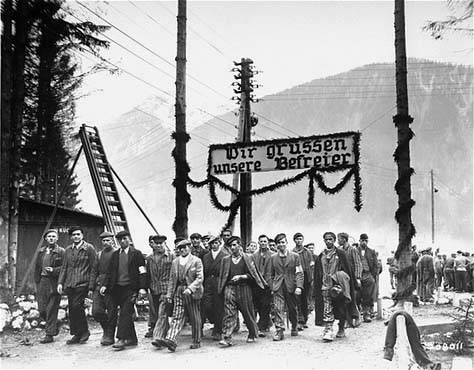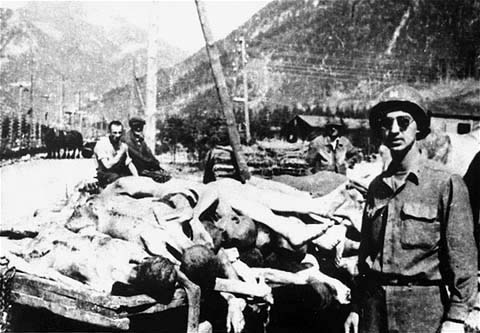Ebensee - subcamp of Mauthausen The photograph above was taken on May 6, 1945, after Ebensee, a sub-camp of the Mauthausen Concentration Camp, was liberated by soldiers in the 80th Division of the US Third Army on May 4th and 5th. The banner, written in French, reads "The French prisoners Salute the Allies." It was erected by the anti-Nazi resistance fighters who were imprisoned here after being captured and accused of doing acts of sabotage during the Nazi occupation of France. The photograph below was erected by the German prisoners. It reads "We welcome our liberators." Among the German prisoners were some who were condemned criminals.  The prisoners at Ebensee worked in underground factories which manufactured Messerschmitt airplanes. German engineers and civilians also worked in these factories. The site was chosen because there were natural caves which could be enlarged into tunnels so that the munitions factories could be protected from Allied bombing raids.  According to Martin Gilbert, the author of a book entitled "Holocaust," Ebensee was an "end destination" for Jewish prisoners who were evacuated from camps farther east as the Soviet Army advanced toward Germany. In the last months of the war, the Ebensee camp was seriously over-crowded with these exhausted prisoners, many of whom had just arrived in the weeks prior to the liberation. Gilbert wrote the following regarding the evacuations and the death marches: Jews who had already survived the 'selections' in Birkenau, and work as slave laborers in factories, had now to survive the death marches. Throughout February and March [1945] columns of men, and crowded cattle trucks, converged on the long-existing concentration camps, now given a new task. These camps had been transformed into holding camps for the remnant of a destroyed people, men and women whose labor was still of some last-minute utility for a dying Reich, or whose emaciated bodies were to be left to languish in agony in one final camp. According to Gilbert's book, a train loaded with 2,059 Jews arrived at Ebensee on March 3, 1945. They had survived the death camp at Auschwitz-Birkenau and had first been sent to the Gross Rosen concentration camp, then on to Ebensee. Forty-nine of the Jewish prisoners died on the train, and on their first day in the camp, 182 died during the disinfection procedure. New arrivals had to be disinfected to kill the body lice which spreads typhus. There was a typhus epidemic in Mauthausen and the sub-camps and, according to Martin Gilbert, 30,000 prisoners died in these camps in the last four months of the war.    In the photograph of three Ebensee survivors above, note the shirt of another man in the background on the right. In place of buttons, his shirt is held together with ties. This shows how much the Nazi concentration camps had deteriorated as the war progressed. During the early days of the camps, strict discipline was enforced and prisoners were punished for having a button missing. By the time the American liberators arrived, the prisoners were lucky to even have a shirt on their backs. According to Martin Gilbert, the last death marches of the war began on May 1, 1945 as the American Army approached; prisoners from the main camp at Mauthausen and the sub-camps at Gusen and St. Valentin were marched to Gunskirchen and Ebensee. Hundreds of them died from exhaustion, or were shot because they couldn't keep up, or as they attempted to escape. When American troops in the 80th Infantry Division arrived on May 4, 1945, there were around 60,000 prisoners from 25 different countries at Ebensee.  In the photograph above, the prisoners all have shaved heads, a procedure which was used in all the Nazi concentration camps in an effort to control the lice which spreads typhus. Their heads were shaved first on the sides and the next time on the top. These prisoners have a regrowth of hair on the top, but have recently been shaved on the sides of their heads. The privileged Kapos were allowed to have a full growth of hair or a beard if they were bald. ContinueHomeThis page was last updated on December 5, 2008 |